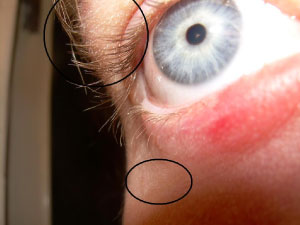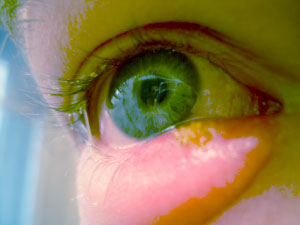

What is Blepharitis?
Blepharitis is an eyelid margin disease that causes persistent inflammation of the eyelids. Symptoms include eye and eyelid irritation, itchiness of the eye, and redness of the eye. This condition frequently occurs in people who have a tendency towards oily skin, dandruff or dysfunctional tear syndrome (dry eyes). With blepharitis, both the upper and lower eyelids become coated with oily particles and bacteria near the base of the eyelashes. It may cause irritation, itchiness, redness, and burning of the eye.
What causes blepharitis?
Everyone has bacteria on the surface of their skin, but in some people, bacteria (usually staphyloccocus epidermidis) thrive in the skin at the base of the eyelashes. They tend to have dandruff-like scales and oily particles around the eyelashes and eyelid margins with large amounts of bacteria. Blepharitis is associated with meibomitis – dysfunction and inflammation of the nearby oil glands of the eyelids (called meibomian glands).
How is blepharitis treated?
Blepharitis is often a chronic condition, but it can be controlled with the following treatment:
Warm compresses.
Wet a clean washcloth with warm water and place it over your closed eyelids for approximately fifteen seconds. Repeat several times, during two to three minutes, rewetting the washcloth as it cools. We recommend the washcloth should be soaking in warm water. This will help prolong the increased temperature, loosen debris around your eyelashes, and mechanically wash out the eyelids. Warm water compresses will dilate the meibomian oil gland drainage ducts and it will dilute (melt) oil secretions. In this way, you will prevent the development of a stye or chalazion (an enlarged gland that feels like a rubbery lump on your lids), caused by clogged oil secretions in the eyelid. Since the washcloth is dripping wet, you will probably have to bend over the wash basin or do this in the shower. You should do this twice daily, when you wake up in the morning and before you go to sleep at night.
Eyelid scrubs.
Using a cotton swab or commercial lint-free pad soaked in warm water; gently scrub the base of your eyelashes for about 15 seconds per eyelid.
Antibiotic ointment.
If appropriate, your ophthalmologist may prescribe an antibiotic ointment. Using a clean fingertip, gently apply a small amount at the base of the eyelashes before bedtime. Artificial tears or steroid eyedrops may also be prescribed temporarily to relieve dry eye symptoms or inflammation.
Good hygiene.
Because blepharitis tends to be a persistent problem, you should practice good skin and eyelid hygiene to prevent recurrences. In addition to careful cleansing of your eyelashes, washing your hair, scalp and eyebrows with antibacterial shampoo can also help control blepharitis.
